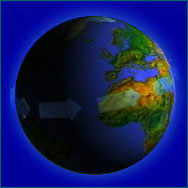 |
 |
 Inside the Jet Stream
Inside the Jet Stream
Jet Stream FAQ
How would you define a jet stream?
The jet stream, one of the most dramatic forces of nature, was discovered
during World War II when aviators first tried to cross the Pacific. This
strong wind current is often defined as upper atmosphere winds that blow faster
than 57 miles per hour.
How high?
At an altitude above 20,000 feet, or between six and nine miles above the
Earth's surface, the jet stream winds make their presence known. This puts
the jet stream near the top of the Earth's troposphere, where most
of the Earth's weather occurs.
 How fast?
How fast?
The core of the jet, a fast-moving wind current that blows west to east
around the Earth, can reach speeds upwards of 300 miles per hour in the
winter. These winds are stronger during the winter months because at this
time of year the surface temperature contrasts are greater. The greater the
contrasts in surface temperature, the stronger the jet stream winds blow.
Length, width, and thickness?
Although the jet stream may stretch for thousands of miles around the world, it
is only a few hundred miles wide and often less than three miles thick.
Does it affect weather?
This strong current of air pushes weather systems around the world, and greatly
affects local weather patterns by propelling them forward.
Does it ever blow north or south?
Because the jet stream winds are greatly affected by changes in temperature,
their trajectory does not always flow in a uniform west to east direction.
Often they might head due north and then arc down in a southerly direction,
creating a wavy pattern or what meteorologists call troughs and ridges.
Solve the Mystery of STENDEC |
Mysterious Plane Crashes
Reading the Wreckage |
Inside the Jet Stream |
Resources
Transcript |
Site Map |
Vanished! Home
Editor's Picks |
Previous Sites |
Join Us/E-mail |
TV/Web Schedule
About NOVA |
Teachers |
Site Map |
Shop |
Jobs |
Search |
To print
PBS Online |
NOVA Online |
WGBH
© | Updated February 2001
|
|
|